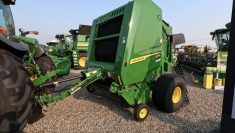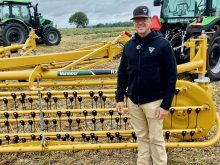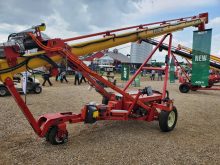Initiative collects research information from around the world to help producers make better choices about crop nutrition
An open-data, crop nutrition platform based on big data and machine learning technology is now available to crop researchers and farmers.
The Consortium for Precision Crop Nutrition (CPCN) led the initiative, which uses technology developed by Agmatix Insights to create an online platform designed to drive international collaboration and expand access to research.
Two active databases were created that enable users to contribute to and use international soil and crop nutrient research.
The first database, called the Global Crop Nutrient Removal Database, includes data on nutrient content, residues, crop yields and other associated data.
Read Also

China’s grain imports have slumped big-time
China purchased just over 20 million tonnes of wheat, corn, barley and sorghum last year, that is well below the 60 million tonnes purchased in 2021-22.
It has a focus on production and environmental factors affecting nutrient concentrations, as well as determining the total amount of nutrients removed from the fields by crops.
The International Fertilizer Association participated in the initiative. Its chief scientist, Achim Dobermann, said the database provides agronomists and farm advisers with the information needed to improve their plant nutrition plans.
So far, the database is focused on corn, wheat, rice and soybean.
The second resource, the Nutrient Omission Trial Database, is focused on crop nutrient requirements. It includes data from researchers and institutes around the globe.
It was built to support site-specific recommendations for nutrient management by enabling researchers to compare crop nutrient requirements and plans.
Dobermann said the information collected in the database will help researchers understand ongoing trends in crop nutrient uptake and removal.
“This will make it easier to create decision support systems to determine how to optimize crop production in a sustainable way, under changing environmental conditions, ultimately facilitating positive long-term changes in how these processes are managed across the industry,” Dobermann said.
He said complex analysis based on big data-based strategies require large data sets, so information collected by a single farmer or even a small set of research trials are inadequate for these algorithms to be useful.
“If you have more data from different situations, neighbouring farms or even farms that are completely different from other parts of the world, you have the ability to construct these kinds of new algorithms,” Dobermann said.
“I think we are still in a stage where we’re learning how to do this. This is a new way of doing this sort of big data analytics. But it starts with having standardized clean data that are easily accessible to everyone and not restricted or not accessible,” Dobermann said.
Agmatix, which focuses on digitizing data from field trials and field experimentation, developed the technology for these databases.
Its chief executive officer, Ron Baruchi, said a significant challenge the agriculture industry faces is the lack of standardization of research data.
“This limits the ability to look at data on a big scale, and many of the people who are developing either the research or new Innovations in the industry have challenges to access high quality data,” Baruchi said.
“Most of the data scientists that I talk to spend 80 percent of the time cleansing the data and standardizing it and connecting it, and only 20 percent actually developing the insights. Here we do the heavy lifting and provide clean, high-quality data for scientists and for agronomists to use for their own research.”
He said users can easily upload the data from their trials, and then include it in larger analyses that include larger data sets.
“Part of what we provide is the ability to gain access to this data very easily and really to shorten the innovation cycle in agriculture,” Baruchi said.
“We have developed the technology that knows how to fuse data from multiple sources into a single database. We also develop different AI models and crop models as well as other predictive capabilities, and we know how to translate those insights into decision support systems.”
He said Agmatix developed a statistical analysis system (SAS) tool to manage field trials and experimentation, which helps it gather more data.
SAS is a programming language for statistical analysis used in data mining and related data handling, and provides results related to multivariate analysis and predictive analytics.
Agmatix also has a self-analysis tool that allows agricultural professionals such as researchers, agronomists and consultant, to perform analysis on data.
Users of Agmatix can generate models from data with just a few clicks.
The system has 14 pre-built widgets that can be used to summarize data, visualize it, compare parameters, and create custom reports.
Baruchi said Agmatix had to create new data pipelines to extract information from international research, and it’s using ontology-based data integration that uses one or more ontologies to effectively combine data or information from multiple dissimilar sources.
“We generate the ontology that represents the economic language and is based on the data which is coming in. We map the different data sources to the right ontologies and after it goes out from this black box it is standardized, which means that the different items can be compared as apples to apples,” Baruchi said,
“Basically, it’s a learning system. So, once you get more and more data, which is from the same domain, it learns automatically to map the different data items to the different ontologies and make this standardized database.”
In data modeling, an ontology is a formal system for modeling concepts and their relationships, while ontologies describe the relationships between concepts by storing them in a graph database.
He said in some cases the data is enriched with additional data layers, and that the outcome of this process is clean data that provides a solid foundation on which to conduct data science.
For the Global Crop Nutrient Removal Database, Dobermann said his organization has helped capture research from many sources.
“We have just grabbed just about anything we can get our hands on. We have scanned the literature on the data and quite old publications that were relevant. You have to extract them out of those publications and put them into the database,” Dobermann said.
“We have sent out an open call to the research community in the world, and asked people to send us your data. We don’t really care what it is, as long as it is relevant to this particular problem.”
He said submissions to the database do not have to be in a specific format in order to encourage as much participation as possible.
Baruchi said the databases were designed with crop researchers and agronomists in mind, but he said there is nothing stopping interested farmers from also using the platform.
“Farmers wouldn’t need to be particularly tech savvy to use the data from the databases as they would be able to run simple analyses on the data and results would be laid out in an easily digestible format,” Baruchi said.
There are already 34 registered users from Canada using the databases.
To use the databases, visit cropnutrientdata.net/.
















